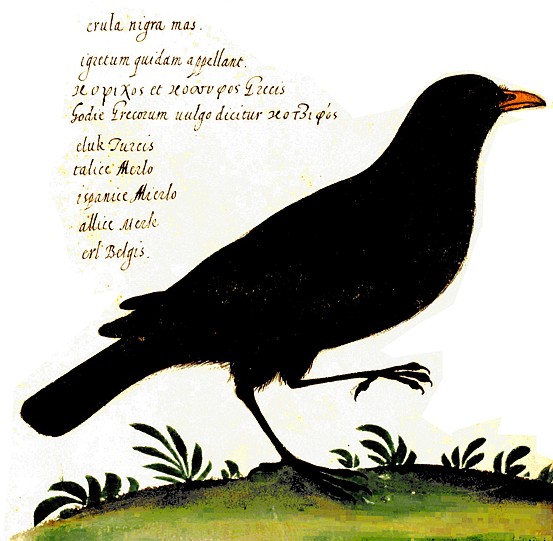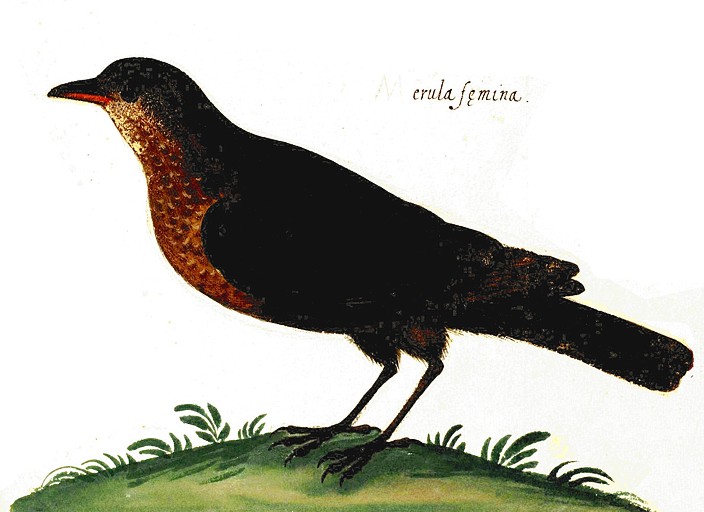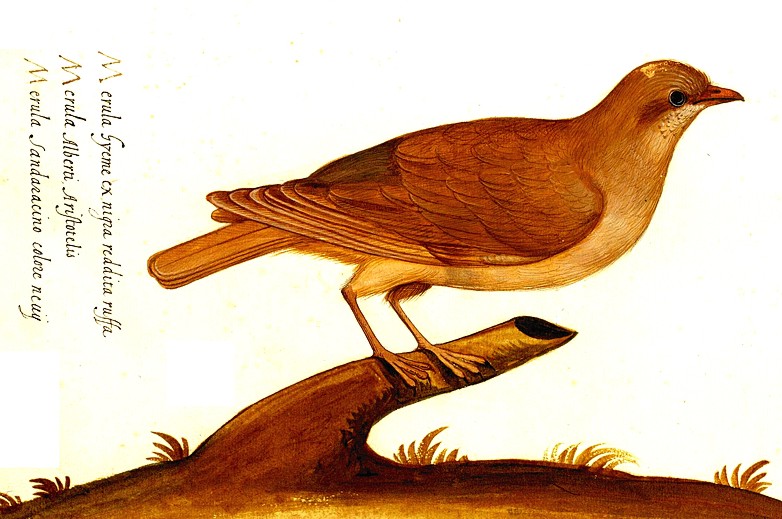Lessico
Cossyphi - Merli
In greco kóssyphos
è il merlo. Nel brano relativo ai polli di Tanagra![]() ,
Gessner (pag. 380
,
Gessner (pag. 380![]() )
e Aldrovandi (pag. 192
)
e Aldrovandi (pag. 192![]() )
ci indurrebbero a prendere un classico granchio:
attraverso l’errata interpretazione del testo greco di Pausania
)
ci indurrebbero a prendere un classico granchio:
attraverso l’errata interpretazione del testo greco di Pausania![]() - dovuta a Abraham Löscher
- dovuta a Abraham Löscher![]() - ci spingerebbero a pensare che nel II secolo dC in Beozia fosse presente la
mutazione barba e favoriti
- ci spingerebbero a pensare che nel II secolo dC in Beozia fosse presente la
mutazione barba e favoriti![]() e magari quella della cresta
doppia
e magari quella della cresta
doppia![]() , il che ha
delle chiare implicazioni fuorvianti per coloro che si dedicano alla
ricostruzione geografica e storica di una mutazione genetica. Per la
prolissa ed esauriente analisi di questo lapsus non dovuto né a Gessner né
ad Aldrovandi si veda l'apposito
capitolo di Summa Gallicana
, il che ha
delle chiare implicazioni fuorvianti per coloro che si dedicano alla
ricostruzione geografica e storica di una mutazione genetica. Per la
prolissa ed esauriente analisi di questo lapsus non dovuto né a Gessner né
ad Aldrovandi si veda l'apposito
capitolo di Summa Gallicana![]() .
.
In
varie specie animali, uomo compreso, è noto l'albinismo![]() .
Anche il pollo non ne è esente
.
Anche il pollo non ne è esente![]() .
A quanto pare non ne è esente neppure il merlo se crediamo a Varrone
.
A quanto pare non ne è esente neppure il merlo se crediamo a Varrone![]() (Durante i pavesamenti pubblici si è soliti porle - le galline selvatiche -
in compagnia dei pappagalli e dei merli albini, nonché di altre simili rarità.
Rerum
rusticarum
III,9,17)
nonché a ciò che ci viene tramandato a proposito dei Giorni della
Merla
(Durante i pavesamenti pubblici si è soliti porle - le galline selvatiche -
in compagnia dei pappagalli e dei merli albini, nonché di altre simili rarità.
Rerum
rusticarum
III,9,17)
nonché a ciò che ci viene tramandato a proposito dei Giorni della
Merla![]() .
Per non parlare poi dei fotografi di Ulisse Aldrovandi - i suoi
affidabilissimi acquarellisti - che ci hanno tramandato la Merula ruffa
.
Per non parlare poi dei fotografi di Ulisse Aldrovandi - i suoi
affidabilissimi acquarellisti - che ci hanno tramandato la Merula ruffa![]() (più corretto sarebbe rufa), ma soprattutto la Merula candida
(più corretto sarebbe rufa), ma soprattutto la Merula candida![]() .
.
Merlo
Turdus merula
Il merlo (Turdus merula, Linnaeus 1758) è un uccello della famiglia dei Turdidae. La specie è caratterizzata da un marcato dimorfismo sessuale: il maschio è lungo fino a 25 centimetri e presenta un piumaggio in genere completamente nero o marrone scuro; il becco e il contorno degli occhi sono di un giallo acceso tendente all'arancione mentre la femmina è di colore bruno scuro, con la gola più chiara, striata. Il maschio immaturo è nero opaco con becco scuro, opaco.
Il merlo è onnivoro; si ciba principalmente di frutta, bacche e piccoli invertebrati. Il suo habitat naturale è il bosco, ma si adatta a vivere in numerosi ambienti (in pratica, ovunque vi siano le condizioni per nidificare) e non raramente lo si trova anche in aree urbane.
Il nido, costruito dalla femmina, si trova sui rami degli alberi, fra i cespugli o anche semplicemente in buche del terreno. La femmina depone le uova (generalmente da 4 a 6) tre volte l'anno, sono di colore azzuro-grigio maculati in modo irregolare da puntini grigi. Il periodo di incubazione va dai 14 ai 15 giorni ed è principalmente la femmina a covarle anche se di rado collabora anche il maschio per motivazioni forse di natura ambientale. In genere, i merli vivono in coppie isolate; durante le migrazioni diventano in genere più sociali e possono radunarsi in stormi.
Il suo canto è un fischio puro molto vario, flautato e sempre allegro, paragonabile a un verso simile a un tciuc-tciuc-tciuc abbastanza basso oppure un sottile tsii o un irritato cie-ciecie, mentre, se allarmato, nel levarsi emette uno stridente e improvviso chiacchierio che potrebbe spaventare qualsiasi distratto che si addentra nel suo habitat senza far caso alla sua posizione. Inoltre ha la capacità di imparare con facilità qualsiasi motivetto per poi ripeterlo fino alla noia. Quando canta tende a porsi verso la cima di un albero. Il suo canto è da molti ritenuto come uno dei più belli e soprattutto allegri.
Può accadere che in lontananza un altro merlo gli alterni le sue emissioni sonore e che ciascuno dei due canti frasi differenti senza sovrapporsi. Dato che il merlo inizia a cantare circa dalle 3 di mattina, può capitare che nelle città possa risultare molesto.
Dopo il passero, il merlo è il passeriforme più diffuso in Europa e in Italia. È diffuso in tutto il territorio europeo ad esclusione della Scandinavia settentrionale. È inoltre presente in Asia, in Africa nord-settentrionale, nelle Canarie e nelle Azzorre. Durante gli inverni si trasferisce dai paesi più settentrionali in quelli più caldi, mentre nelle zone temperate come l'Italia è presente tutto l'anno.
Vive generalmente nei boschi con sottobosco, nei frutteti e nei vigneti, ed è comune presso tutte le zone coltivate.
Acquarelli![]() di Ulisse Aldrovandi
di Ulisse Aldrovandi
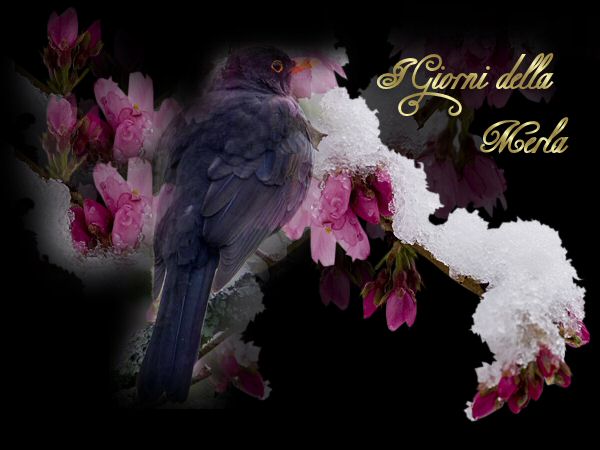
I tre giorni della merla sono considerati, da noi, i giorni più freddi dell'anno. Se sono freddi, la Primavera sarà bella, se sono caldi la Primavera arriverà tardi. Le leggende intorno a questa tradizione sono molte.
1 - Una volta i merli erano bianchi. Un giorno, per il troppo freddo, uno entrò in un camino per scaldarsi e ne uscì dopo tre giorni tutto nero per la fuliggine.
2 - Due merli dalle candide piume, maschio e femmina, si ripararono per il freddo in un camino. Non avendo nulla da mangiare, il maschio decise di uscire per cercare qualcosa. Dopo tre giorni tornò e trovando un uccello nero come il carbone, non riconobbe la sua merla e tornò indietro per cercarla. La merla, annerita per la fuliggine, nel frattempo morì di fame.
3 - Alla fine di gennaio il merlo e la merla si sposano, al paese della sposa, oltre il Po. Dovrebbero riattraversarlo per tornare nella loro casa, ma si è fatto tardi e si fermano per due giorni presso dei parenti. La temperatura si abbassa molto. Merlo è costretto ad attraversare il Po ghiacciato, ma muore. Merla piange e il suo lamento si sente ancora lungo il Po, nelle notti di fine gennaio.
http://www.european-schoolprojects.net

I Tre Giorni della Merla
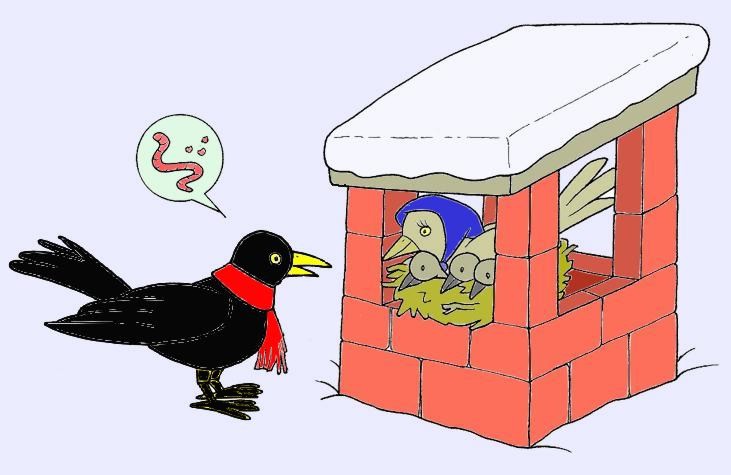
Tanto, tanto tempo fa, a Milano ci fu un inverno molto rigido. La neve scendeva dal cielo e copriva tutta la città, le strade, i giardini. Sotto la grondaia di un palazzo in Porta Nuova c'era un nido di una famigliola di merli, che a quel tempo avevano le piume bianche come la neve. C'era la mamma merla, il papà merlo e tre piccoli uccellini, nati dopo l'estate. La famigliola soffriva il freddo e stentava a trovare qualche briciola di pane per sfamarsi, perché le poche briciole che cadevano in terra dalle tavole degli uomini venivano subito ricoperte dalla neve che scendeva dal cielo. Dopo qualche giorno il papà merlo prese una decisione e disse alla moglie:
"Qui non si trova nulla da mangiare, se continua così moriremo tutti di fame e di freddo. Ho un'idea, ti aiuterò a spostare il nido sul tetto del palazzo, a fianco a quel camino, così mentre aspettate il mio ritorno non avrete freddo. Io parto e vado a cercare il cibo dove la neve non è ancora arrivata".
E così fu fatto: il nido fu messo vicino al camino e il papà partì. La mamma e i piccoli uccellini stavano tutto il giorno nel nido scaldandosi tra loro e anche grazie al fumo che usciva tutto il giorno dal camino. Dopo tre giorni il papà tornò a casa e quasi non riuscì più a riconoscere la sua famiglia! Il fumo nero che usciva dal camino aveva colorato di nero tutte le piume della mamma e degli uccellini!
Per fortuna da quel giorno l'inverno divenne meno rigido e i merli riuscirono a trovare cibo sufficiente per arrivare alla primavera. Da quel giorno però tutti i merli nascono con le piume nere e per ricordare la famigliola di merli bianchi divenuti neri gli ultimi tre giorni del mese di gennaio, questi sono detti i Tre Giorni della Merla.
Anonimo
http://www.pinu.it/giorni_merla.htm
I Giorni della Merla
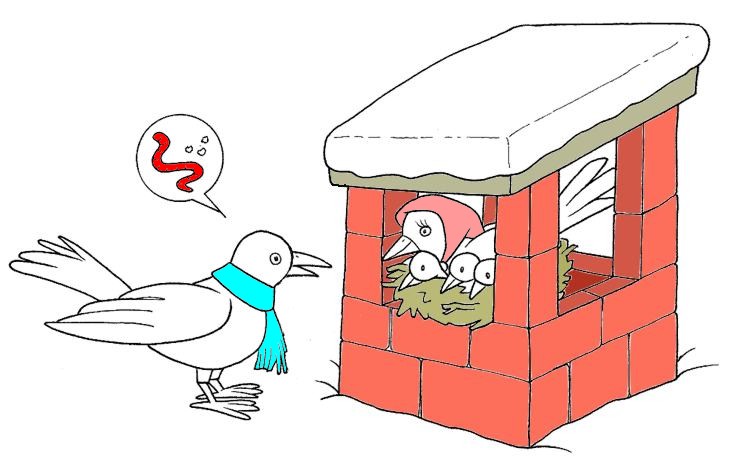
I cosiddetti giorni della merla sono, secondo la tradizione, gli ultimi tre giorni di gennaio, ovvero 29, 30 e 31; sono considerati i giorni più freddi dell'inverno. Il nome deriverebbe da una leggenda secondo la quale, per ripararsi dal gran freddo, una merla e i suoi pulcini, in origine bianchi, si rifugiarono dentro un comignolo, dal quale emersero il 1º febbraio, tutti neri a causa della fuliggine. Da quel giorno tutti i merli furono neri.
Secondo una versione più elaborata della leggenda, una merla, con uno splendido candido piumaggio, era regolarmente strapazzata da Gennaio, mese freddo e ombroso, che si divertiva ad aspettare che la merla uscisse dal nido in cerca di cibo per gettare sulla terra freddo e gelo. Stanca delle continue persecuzioni, la merla un anno decise di fare provviste sufficienti per un mese e si rinchiuse nella sua tana, al riparo, per tutto il mese di Gennaio, che allora aveva solo 28 giorni. L'ultimo giorno del mese, la merla pensando di aver ingannato il cattivo Gennaio, uscì dal nascondiglio e si mise a cantare per sbeffeggiarlo. Gennaio si risentì talmente tanto che chiese in prestito tre giorni a Febbraio e si scatenò con bufere di neve, vento, gelo, pioggia. La merla si rifugiò alla chetichella in un camino, e lì restò al riparo per tre giorni. Quando la merla uscì, era sì, salva, ma il suo bel piumaggio si era annerito a causa del fumo e così rimase per sempre con le piume scure.
Come in tutte le leggende si nasconde un fondo di verità: anche in questa versione possiamo trovarne un po'. Infatti nel calendario romano il mese di gennaio aveva solo 29 giorni, che probabilmente con il passare degli anni e del tramandarsi oralmente si tramutarono in 31. Sempre secondo la leggenda, se i Giorni della Merla sono freddi, la Primavera sarà bella, se sono caldi la Primavera arriverà in ritardo. Per quanto la leggenda parli di una merla, nella realtà questi uccelli presentano un forte dimorfismo sessuale nella livrea, che è bruna - becco incluso - nelle femmine, mentre è nera brillante - con becco giallo-arancione - nel maschio.
Ma quanto c’è di vero nella tradizionale credenza che gli ultimi tre giorni di gennaio siano i più freddi dell’anno? Ben poco, se prendiamo in considerazione i dati del Centro Geofisico Prealpino nel periodo 1967-1999. Da questi risulta infatti che la temperatura media dei giorni 29-30-31 gennaio è stata di 3.6 °C. Mentre la temperatura media di gennaio, calcolata sullo stesso periodo di osservazioni, è di 2.8 °C. Per cui la media di questi tre ultimi giorni risulta di quasi un grado (esattamente 0.8 °C) più alta. Infatti statisticamente dopo il 10 di gennaio la temperatura tende ad aumentare.
I giorni della merla a Lodi vengono festeggiati da cori che, posti sulle rive opposte dell'Adda, si chiamano e rispondono, la strofa iniziale di questo botta e risposta dice: « tra la ruca in mez a l'era, se ghe nigul se insirena » (butta la rocca in mezzo all'aia, se è nuvolo verrà il sereno).
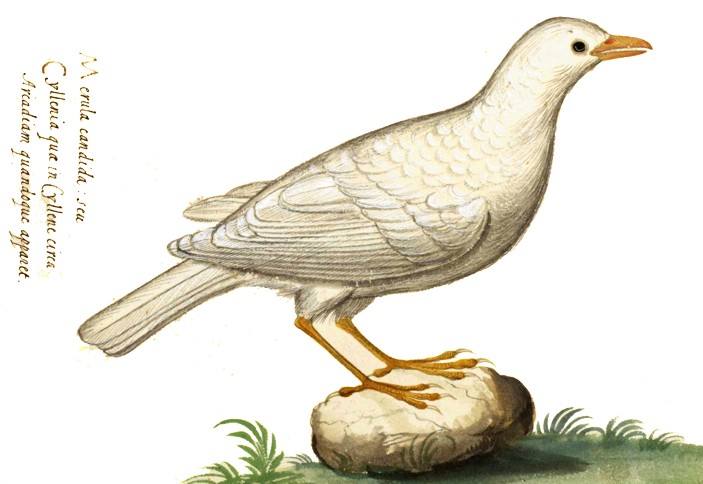
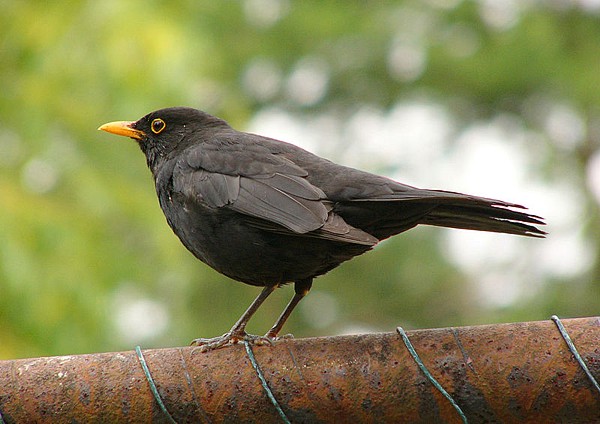
The Blackbird, Common Blackbird or Eurasian Blackbird (Turdus merula) is a species of true thrush which breeds in Europe, Asia, and North Africa, and has been introduced to Australia and New Zealand. It has a number of subspecies across its large range; a few of the Asian subspecies are sometimes considered as full species. Depending on latitude, the Blackbird may be resident, partially migratory or fully migratory.
The male of the nominate subspecies, which is found throughout most of Europe, is all black except for a yellow eye-ring and bill and has a wide range of vocalisations; the adult female and juvenile have mainly brown plumage. This species breeds in woods and gardens, building a neat, mud-lined, cup-shaped nest. It is omnivorous, eating a wide range of insects, earthworms, seeds, berries, and fruits.
Both sexes are territorial on the breeding grounds, with distinctive threat displays, but are more gregarious during migration and in wintering areas. Pairs will stay in their territory throughout the year where the climate is sufficiently temperate. This common species has given rise to a number of literary and cultural references, frequently related to its melodious song.
Taxonomy
The
Blackbird was described by Linnaeus in his Systema Naturae in 1758 as Turdus
merula (characterised as Turdus ater, rostro palpebrisque fulvis). The
binomial name derives from two Latin words, Turdus, "thrush",
and merula, "blackbird", the latter giving rise to the French
name for this species, merle. There are about 65 species of medium to large
thrushes in the genus Turdus![]() ,
characterised by rounded heads, longish pointed wings, and usually melodious
songs. The Blackbird seems to be closest in evolutionary terms to the Island
Thrush (Turdus poliocephalus) of the southwest Pacific, which probably
diverged from merula stock fairly recently.
,
characterised by rounded heads, longish pointed wings, and usually melodious
songs. The Blackbird seems to be closest in evolutionary terms to the Island
Thrush (Turdus poliocephalus) of the southwest Pacific, which probably
diverged from merula stock fairly recently.
It is not immediately clear in modern English why the name "Blackbird", first recorded in 1486, was applied to this species, but not to another common black European bird, such as the Carrion Crow, Raven, Rook or Jackdaw. However, in Old English, and in modern English up to about the 18th Century, "bird" was used only for smaller or young birds, and larger ones, such as crows were called "fowl". The Blackbird was therefore the only widespread and conspicuous "black bird" in the British Isles. Until about the 17th century, another usual name for the species was ouzel, ousel or wosel (from Old English osle). Another variant occurs in Act 3 of Shakespeare's A Midsummer Night's Dream, where Bottom refers to The Woosell cocke, so blacke of hew, With Orenge-tawny bill. The ousel usage survived later in poetry, and still occurs as the name of the closely related Ring Ouzel, and in Water Ouzel, an alternative name for the unrelated but superficially similar White-throated Dipper (Cinclus cinclus).
Two related Asian Turdus thrushes, the White-collared Blackbird (Turdus albocinctus) and the Grey-winged Blackbird (Turdus boulboul), are also named as blackbirds, and the Somali Thrush (Turdus(olivaceus) ludoviciaeis) is alternatively known as the Somali Blackbird.
Around 20 species of the New World icterid family are named as blackbirds because of their superficial resemblance to the Old World thrushes, but they are not closely related, being nearer to the New World warblers and tanagers in evolutionary terms. They include the Red-winged Blackbird (Agelaius phoeniceus), Red-breasted Blackbird (Sturnella militaris), Yellow-headed Blackbird (Xanthocephalus xanthocephalus) and the Melodious Blackbird (Dives dives).
Description
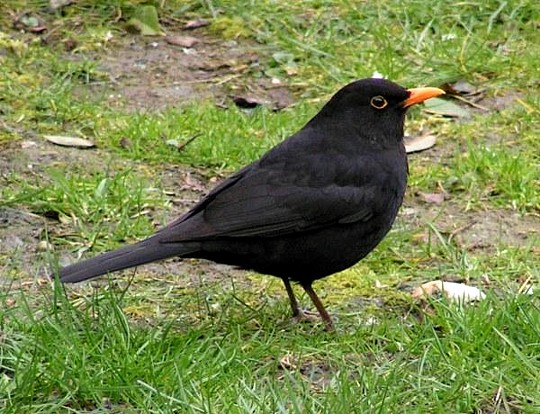
The Blackbird of the nominate subspecies Turdus merula merula is 23.5 to 29 centimetres (9.25 to 11.4 in) in length, has a long tail, and weighs 80–125 grammes (2.8 to 4.4 oz). The adult male has glossy black plumage, blackish-brown legs, a yellow eye-ring and an orange-yellow bill. The bill darkens somewhat in winter.

The adult female is sooty-brown with a dull yellowish-brownish bill, a brownish-white throat and some weak mottling on the breast. The juvenile is similar to the female, but has pale spots on the upperparts, and the very young juvenile also has a speckled breast.
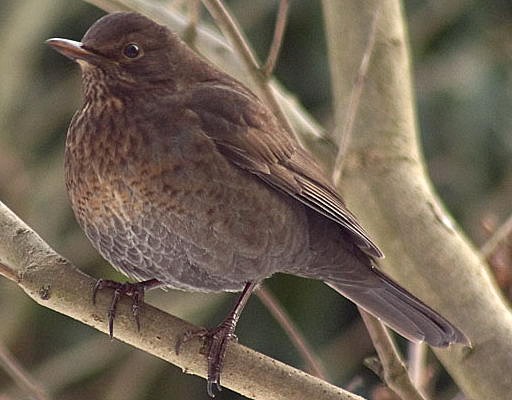
Young birds vary in the shade of brown, with darker birds presumably males. The first year male resembles the adult male, but has a dark bill and weaker eye ring, and its folded wing is brown, rather than black like the body plumage.
Subspecies
As would be expected for a widespread passerine bird species, several geographical subspecies are recognised. The treatment of subspecies in this article follows Clement et al (2000).
T.
m. merula, the nominate subspecies, breeds commonly throughout much of
Europe from Iceland, the Faeroes and the British Isles east to the Ural
Mountains and north to about 70 N, where it is fairly scarce. A small
population breeds in the Nile valley. Birds from the north of the range winter
throughout Europe and around the Mediterranean including Cyprus and North
Africa. The introduced birds in Australia and New Zealand are of the nominate
race.
T. m. azorensis is a small race which breeds in the Azores. The male is
darker and glossier than merula.
T. m. cabrerae, named for Ángel Cabrera, Spanish zoologist, resembles azorensis
and breeds in Madeira and the western Canary Islands.
T. m. mauretanicus, another small dark species with a glossy black male
plumage, breeds in central and northern Morocco, coastal Algeria and northern
Tunisia.
T m. aterrimus breeds in Hungary, south and east to southern Greece,
Crete northern Turkey and northern Iran. It winters in southern Turkey,
northern Egypt, Iraq and southern Iran. It is smaller than merula with
a duller male and paler female plumage.
T. m. syriacus breeds on the Mediterranean coast of southern Turkey
south to Jordan, Israel and the northern Sinai. It is mostly resident, but
part of the population moves south west or west to winter in the Jordan Valley
and in the Nile Delta of northern Egypt south to about Cairo. Both sexes of
this subspecies are darker and greyer than the equivalent merula
plumages.
T. m. intermedius is an Asiatic race breeding from Central Russia to
Tajikistan, western and north east Afghanistan, and eastern China. Many birds
are resident but some are altitudinal migrants and occur in southern
Afghanistan and southern Iraq in winter. This is a large subspecies, with a
sooty-black male and a blackish-brown female.
T. m. maximus is a large montane subspecies found from eastern
Afghanistan east through the Himalayas between 3200 and 4800 metres
(10,560–16,000 ft) to Sikkim, Assam, southern Tibet and western Szechwan,
China. It is an altitudinal migrant, and in winter occurs down to 2100 metres
(6930 ft) in south east Tibet, but not below 3000 metres (9900 ft) further
west. The male is black and the female very dark brown. It is the only
subspecies without a yellow or orange eye-ring.
T. m. mandarinus breeds throughout much of south, central and east
China. It is a partial migrant to Hong Kong and south to Laos and Vietnam. The
male is sooty black, and the female is similar but browner, and paler on the
underparts. It is a large subspecies.
T. m. sowerbyi, named for James Sowerby, British naturalist and
illustrator, breeds from east Szechwan to Guizhou. It is partially migratory,
with some individuals spending the winter in south China and north Indochina.
It resembles mandarinus, but is smaller and darker below.
T. m. nigropileus is resident up to about 1820 metres (6000 ft) in the
Western Ghats of western India and the northern and central parts of the
Western Ghats. The male is brownish slate-grey with a dark cap, and the female
is mid-brown, paler below. It is small with a relatively broad yellow
eye-ring.
T. m. spencei, named for William Spence, British entomologist, is very
similar to nigropileus, but has a less distinct cap. It is resident in
the highlands of eastern India. It is of dubious validity, and is often
included in nigropileus.
T. m. simillimus is a common resident of the hills in Kerala and Tamil
Nadu, south west India. It is darker than spencei.
T. m. bourdilloni, named for Thomas Fulton Bourdillon, Conservator of
Forests in the then princely state of Travancore, is a common resident of the
hills above 900 metres (3000 ft) in southern Kerala and Tamil Nadu. It
resembles simillimus, but the male is uniform slate brown.
T. m. kinnisii, named for John Kinnis, surgeon to the British military
forces in what was then Ceylon, breeds in the hills of Sri Lanka above 900
metres (3000 ft). The male is uniformly blue-grey, and the female is similar
but browner. Size as in nigropileus, but eye-ring more reddish-orange.
The taxonomy, especially of the Asian subspecies, is complex. The subspecies from most of the Indian subcontinent, simillimus, nigropileus, bourdilloni, spencei, and kinnissi, are small, only 19–20 centimetres (7.5–8 in) long, and have broad eye-rings. They also differ in proportions, wing formula, egg colour and voice from the other subspecies of the Blackbird. They are therefore sometimes considered a separate species, the Indian Blackbird (T. simillimus). The Himalayan subspecies maximus is strikingly different from the simillimus group, being relatively large at 23–28 centimetres (9–11 in) length. It differs from all other subspecies of the Blackbird by its complete lack of eye-ring and reduced song. It is therefore sometimes considered a full species, the Tibetan Blackbird (T. maximus). The remaining Asian subspecies, the relatively large intermedius and mandarinus, and the smaller sowerbyi, also differ in structure and voice, and may represent a third species, the Chinese Blackbird (T. mandarinus). Alternatively, it has been suggested that they should be considered subspecies of T. maximus, but they differ in structure, voice and the appearance of the eye-ring.
Similar species
In Europe, the Blackbird can be confused with the paler-winged first-winter Ring Ouzel (Turdus torquatus) or the superficially similar European Starling (Sturnus vulgaris). The Sri Lankan subspecies, T. m. kinsii, resembles the Sri Lanka Whistling-thrush (Myophonus blighi) and the out-of-range Tickell's Thrush (Turdus unicolor).However, the former species always has blue in the plumage, and the latter has a pale belly. A number of similar Turdus thrushes exist far outside the range of the Blackbird, for example the South American Chiguanco Thrush (Turdus chiguanco).
Distribution and habitat

The Blackbird breeds in temperate Eurasia, North Africa, the Canary Islands, and South Asia. It has been introduced to Australia and New Zealand. Populations are sedentary in the south and west of the range, although northern birds migrate south as far as northern Africa and tropical Asia in winter. Urban males are more likely to overwinter in cooler climes than rural males, an adaptation made feasible by the warmer microclimate and relatively abundant food that allow the birds to establish territories and start reproducing earlier in the year.
Common over most of its range in woodland, the Blackbird has a preference for deciduous trees with dense undergrowth. However, gardens provide the best breeding habitat with up to 7.3 pairs per hectare (nearly three pairs per acre), with woodland typically holding about a tenth of that density, and open and very built-up habitats even less. They are often replaced by the related Ring Ouzel in areas of higher altitude.
The Blackbird occurs up to 1000 metres (3300 ft) in Europe, 2300 metres (7590 ft) in North Africa, and at 900–820 metres (3000–6000 ft) in peninsular India and Sri Lanka, but the large Himalayan subspecies range much higher, with T. m. maximus breeding at 3200–4800 metres (10560–16000 ft) and remaining above 2100 metres (6930 ft) even in winter.
This widespread species has occurred as a vagrant in many locations in Eurasia outside its normal range, but records from North America are normally considered to involve escapees, including, for example, the 1971 bird in Quebec. However, a 1994 record from Bonavista, Newfoundland has been accepted as a genuine wild bird, and the species is therefore on the North American list.
Status
The Blackbird has an extensive range, estimated at 10 million square kilometres (3.8 million square miles), and a large population, including an estimated 79 to 160 million individuals in Europe alone. The species is not believed to approach the thresholds for the population decline criterion of the IUCN Red List (i.e., declining more than 30% in ten years or three generations), and is therefore evaluated as Least Concern. In the western Palaearctic, populations are generally stable or increasing, but there have been local declines, especially on farmland, which may be due to agricultural policies that encouraged farmers to remove hedgerows (which provide nesting places), and to drain damp grassland and increase the use of pesticides, both of which could have reduced the availability of invertebrate food.
The Blackbird was introduced to Australia at Melbourne in the 1850s, but has expanded from its initial foothold in Melbourne and Adelaide to occur throughout south-eastern Australia, including Tasmania and the Bass Strait islands. The introduced population in Australia is considered a pest because it damages a variety of soft fruits in orchards, parks and gardens including berries, cherries, stone fruit and grapes. It is thought to spread weeds, such as blackberry, and may compete with native birds for food and nesting sites.
The introduced Blackbird is, together with the native Silvereye (Zosterops lateralis), the most widely distributed avian seed disperser in New Zealand. Introduced there along with the Song Thrush (Turdus philomelos) in 1862, it has spread throughout the country up to an elevation of 1,500 metres (4,921 ft), as well as outlying islands such as the Campbell and Kermadecs. It eats a wide range of native and exotic fruit, and makes a major contribution to the development of communities of naturalised woody weeds. These communities provide fruit more suited to non-endemic native birds and naturalised birds, than to endemic birds.
Behaviour
The male Blackbird defends its breeding territory, chasing away other males or utilising a "bow and run" threat display. This consists of a short run, the head first being raised and then bowed with the tail dipped simultaneously. If a fight between male Blackbirds does occur, it is usually short and the intruder is soon chased away. The female Blackbird is also aggressive in the spring when it competes with other females for a good nesting territory, and although fights are less frequent, they tend to be more violent.
The bill’s appearance is important in the interactions of the Blackbird. The territory-holding male responds more aggressively towards models with orange bills than to those with yellow bills, and reacts least to the brown bill colour typical of the first-year male. The female is, however, relatively indifferent to bill colour, but responds instead to shinier bills.
As long as winter food is available, both the male and female will remain in the territory throughout the year, although occupying different areas. Migrants are more gregarious, travelling in small flocks and feeding in loose groups in the wintering grounds. The flight of migrating birds comprises bursts of rapid wing beats interspersed with level or diving movement, and differs from both the normal fast agile flight of this species and the more dipping action of larger thrushes.
Breeding
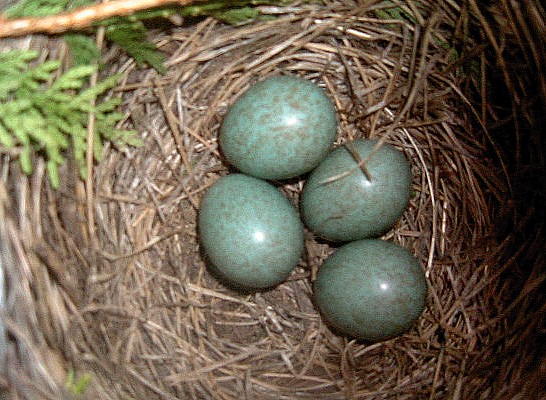
The male Blackbird attracts the female with a courtship display which consists of oblique runs combined with head-bowing movements, an open beak, and a "strangled" low song. The female remains motionless until she raises her head and tail to permit copulation. This species is monogamous, and the established pair will usually stay together as long as they both survive. Pair separation rates of up to 20% have been noted following poor breeding. Although socially monogamous, there have been studies showing as much as 17% extra pair paternity.
Nominate T. merula may commence breeding in March, but eastern and Indian races are a month or more later, and the introduced New Zealand birds start nesting in August. The breeding pair prospect for a suitable nest site in a creeper or bush, favouring evergreen or thorny species such as ivy, holly, hawthorn, honeysuckle or pyracantha, and the female builds a neat cup-shaped nest from grasses and similar vegetation, which she then lines with mud or muddy leaves. She lays three to five (usually four) bluish-green eggs marked with reddish-brown blotches, heaviest at the larger end; the eggs of nominate T. merula are 2.9 x 2.1 centimetres (1.14 x 0.93 in) in size and weigh 7.2 g (0.25 oz), of which 6% is shell. Eggs of birds of the southern Indian races are paler than those from the northern subcontinent and Europe.

The female incubates for 12–14 days before the altricial chicks are hatched naked and blind. Fledging takes another 10–19 (average 13.6) days, with both parents feeding the young and removing faecal sacs. The young are fed by the parents for up to three weeks after leaving the nest, and will follow the adults begging for food. If the female starts another nest, the male alone will feed the fledged young. Second broods are common, with the female reusing the same nest if the brood was successful, and three broods may be raised in the south of the Blackbird's range.
Montane subspecies, such as T. maximus have a shorter breeding season, smaller clutches (2–4 eggs, averaging 2.86), but larger eggs than merula. They produce just one brood per year, and have a slightly shorter incubation period of 12–13 days, but a longer nestling period (16–18 days).
A Blackbird has an average life expectancy of 2.4 years, and, based on data from bird ringing, the oldest recorded age is 21 years and 10 months.
Songs and calls
The first-year male Blackbird of the nominate race may start singing as early as late January in fine weather in order to establish a territory, followed in late March by the adult male. The male's song is a varied and melodious low-pitched fluted warble, given from trees, rooftops or other elevated perches mainly in the period from March to June, sometimes into the beginning of July. It has a number of other calls, including an aggressive seee, a pook-pook-pook alarm for terrestrial predators like cats, and various chink and chook, chook vocalisations. The territorial male invariably gives chink-chink calls in the evening in an (usually unsuccessful) attempt to deter other Blackbirds from roosting in its territory overnight. Like other passerine birds, it has a thin high seee alarm call for threats from birds of prey since the sound is rapidly attenuated in vegetation, making the source difficult to locate.
At least two subspecies, T. m. merula and T. m. nigropileus, will mimic other species of birds, cats, humans or alarms, but this is usually quiet and hard to detect. The large mountain races, especially T. m. maximus, have comparatively poor songs, with a limited repertoire compared with the western, peninsular Indian and Sri Lankan taxa.
Feeding
The Blackbird is omnivorous, eating a wide range of insects, earthworms, seeds and berries. It feeds mainly on the ground, running and hopping with a start-stop-start progress. It pulls earthworms from the soil, usually finding them by sight, but sometimes by hearing, and roots through leaf litter for other invertebrates. Small vertebrates such as frogs, tadpoles and lizards are occasionally hunted. This species will also perch in bushes to take berries and collect caterpillars and other active insects. Animal prey predominates, and is particularly important during the breeding season, with windfall apples and berries taken more in the autumn and winter. The nature of the fruit taken depends on what is locally available, and frequently includes exotics in gardens. In northern India, banyan and mulberry fruits are frequently eaten, with Erythrina and Trema species featuring further south.
Natural threats
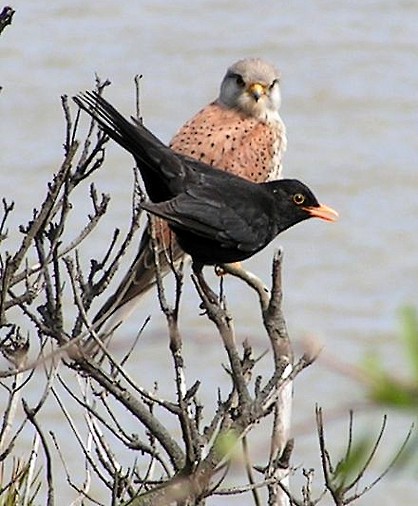
A male attempting to distract a male Kestrel - Falco tinnunculus - close to its nest
The main predator of the Blackbird is the domestic cat, but foxes and predatory birds, such as the Sparrowhawk* and other accipiters, also take this species when the opportunity arises. In contrast, there is little direct evidence to show that either predation of the adult Blackbirds or loss of the eggs and chicks to corvids, such as the European Magpie or Eurasian Jay, have a direct impact on population numbers.
This species is occasionally a host of parasitic cuckoos, such as the Common Cuckoo (Cuculus canorus), but this is minimal because the Blackbird recognizes the adult of the parasitic species and its non-mimetic eggs. The introduced merula Blackbird in New Zealand, where the cuckoo does not occur, has, over the past 130 years, lost the ability to recognize the adult Common Cuckoo but still rejects non-mimetic eggs.
As with other passerine birds, parasites are common. 88% of blackbirds were found to have intestinal parasites, most frequently Isospora and Capillaria species, and more than 80% had haematozoan parasites. Blackbirds spend much of their time looking for food on the ground where they can become infested with ticks, which are external parasites that most commonly attach to the head of a Blackbird. In France 74% of rural Blackbirds were found to be infested with Ixodes ticks, whereas, only 2% of Blackbirds living in rural habitats were infested. This is partly because it is more difficult for ticks to find another host on lawns and gardens than in uncultivated rural areas, and partly because ticks are likely to be commoner in rural areas, where a variety of tick hosts, such as foxes, deer and boar, are more numerous. Although, ixodid ticks can transmit pathogenic viruses and bacteria, and are known to transmit Borrelia bacteria to birds, there is no evidence that this affects the fitness of Blackbirds except when they are exhausted and rundown after migration.
In culture
The
Blackbird was seen as a sacred though destructive bird in Classical Greek
folklore, and was said to die if it consumed pomegranate![]() . Like
many other small birds, it has in the past been trapped in rural areas at its
night roosts as an easily available addition to the diet, and in medieval
times the conceit of placing live birds under a pie crust just before serving
may have been the origin of the familiar nursery rhyme:
. Like
many other small birds, it has in the past been trapped in rural areas at its
night roosts as an easily available addition to the diet, and in medieval
times the conceit of placing live birds under a pie crust just before serving
may have been the origin of the familiar nursery rhyme:
Sing a
song of sixpence,
A pocket full of rye;
Four and twenty blackbirds baked in a pie!
When the pie was opened the birds began to sing,
Oh wasn't that a dainty dish to set before the king?
The Blackbird's melodious, distinctive song is the theme of the poem Adelstrop by Edward Thomas:
And for
that minute a blackbird sang
Close by, and round him, mistier,
Farther and farther, all the birds
Of Oxfordshire and Gloucestershire.
The song is also recalled in the Beatles track Blackbird:
Blackbird singing in the dead of night,
Take these broken wings and learn to fly
All your life,
You were only waiting for this moment to arise.
The Blackbird, unlike many black creatures, is not normally seen as a symbol of bad luck, but R. S. Thomas wrote that there is "a suggestion of dark Places about it", and it symbolised resignation in the 17th century tragic play The Duchess of Malfi; an alternate connotation is vigilance, the bird's clear cry warning of danger.
The Blackbird is the national bird of Sweden, which has a breeding population of 1-2 million pairs, and was featured on a 30 öre Christmas postage stamp in 1970.
Le merle noir ou simplement merle (Turdus merula) est un membre européen de la famille des Turdidés. Il est très commun dans les bois et les jardins de toute l'Europe et d'une grande partie de l'Asie, en dessous du cercle polaire arctique. Les populations sont généralement sédentaires, mis à part les oiseaux vivant au nord, qui migrent vers le sud en hiver. En France, les effectifs de merles sont estimés à plusieurs dizaines de millions de couples.
Les merles noirs sont omnivores, se nourrissant d'insectes, de vers et de baies. Ils nidifient dans les buissons ou les arbustes. La femelle pond plusieurs œufs bleu-vert-gris (habituellement 4), avec des marques brunes ou rouges, dans un joli nid en forme de coupelle. Les merles adultes pèsent en moyenne de 85 à 115 g et mesurent 25 cm.
Les merles ne vivent pas en groupe, bien que plusieurs oiseaux puissent plus ou moins cohabiter dans un habitat convenable en dehors de la période de reproduction. Par contre, durant cette période, les merles ne supportent aucun congénère sur leur territoire (qui varie de 0,2 à 0,5 ha en forêt, et de 0,1 à 0,3 ha en ville), en dehors de leur partenaire.
Les mâles adultes sont complètement noirs, mis à part un bec jaune ainsi qu'un cercle jaune autour des yeux. La femelle a un plumage brun, dont les tons varient d'un individu à l'autre, et ne possède pas le bec et l'anneau orbital jaune brillant du mâle. Quant aux juvéniles, ils possèdent un plumage brun moucheté de blanc qui dure jusqu'à leur première mue, entre août et octobre. Le bec des jeunes mâles n'atteint sa couleur jaune qu'après une année complète.
Dès la fin de l'hiver, et jusqu'au début de l'été, le merle mâle siffle des chants variés et mélodieux depuis le haut des arbres, le toit des maisons ou tout autre perchoir dominant les environs. Le merle peut chanter à toute heure de la journée mais le lever et le coucher du soleil sont les moments où les chants retentissent de manière plus intense. Le chant du merle noir est considéré comme l'un des plus beaux chants d'oiseaux d'Europe. La richesse du répertoire, les variations mélodiques et ses capacités d'improvisation distinguent le merle de la plupart des autres oiseaux.
L'espérance de vie d'un merle se situe habituellement autour de 3 ou 4 ans. Certains individus ont cependant atteint des records de longévité d'une quinzaine d'années. Le merle possède de nombreux prédateurs, en particulier l'épervier d'Europe . Certains autres oiseaux, comme les pies et les corneilles, mais aussi d'autres animaux, comme les fouines, les hermines et les chats, ont l'habitude de piller les nids de merles, ce qui peut limiter leur population. Dans le sud de la France, le merle paie aussi son tribut à la chasse à la grive, car de manière officielle, aucune distinction n'est faite entre merles et grives.
Le merle noir a été introduit dans de nombreuses parties du monde en dehors de son aire originelle. Par exemple, en Australie et en Nouvelle-Zélande, se trouvent des descendants de merles importés de Grande-Bretagne. Les variétés blanc et albinos sont considérées comme domestiques.
